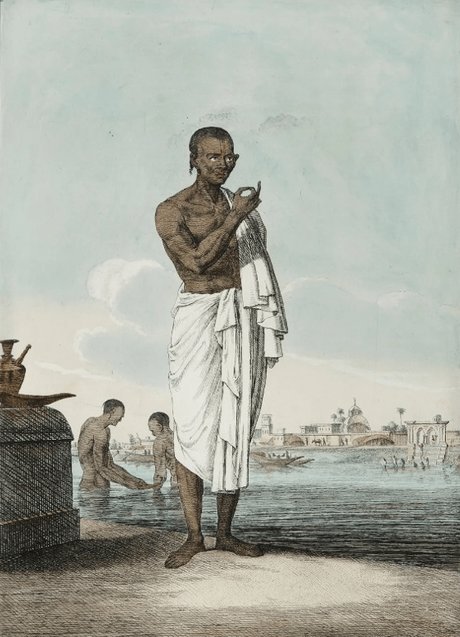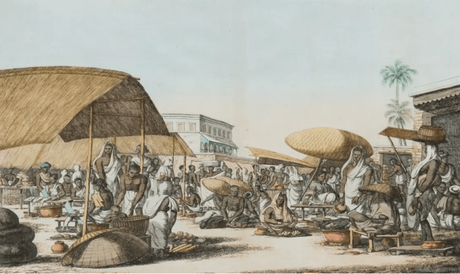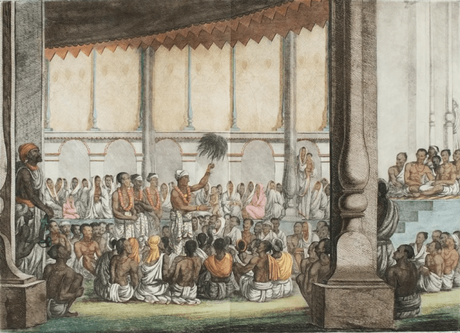Guest Post by Bindu Gopal Rao
DAG’s first-ever exhibition of the complete series of 288 etchings by Baltazard Solvyns called Les Hindoûs is a documentation of life in Bengal during the 1790’s.
Francois Baltazard Solvyns (1760-1824), a Flemish printmaker and ethnographer came to India in 1791 with the hope of making his fortune and lived in Calcutta without permission from the board of the East India Company. While picking up odd jobs, he embarked on an ambitious project to produce a comprehensive survey of ‘the manners, customs, and dresses of the Hindus’.

It was this effort that made it to the first edition, containing 250 hand coloured etchings, published in Calcutta between 1796 and 1799 but it was not successful commercially. It is believed that at that time most of the audience was accustomed to picturesque landscapes. Solvyns focus on ordinary people had a more somber mood hence did not strike the right chord. Solvyns returned to Europe and published the next edition between 1808-1812 in Paris as a differently arranged book in four volumes, with bilingual descriptive text in French and English, and some additional plates, making it a total of 288 illustrations. This is the work that is being exhibited for the first time as a complete set.

Established in 1993, DAG is an art company whose exhibitions and books have helped establish Indian art around the world, its repertoire spanning pre-modern art as well as modern masters. Curated by Dr. Giles Tillotson, Senior Vice President, Exhibitions and Publications at DAG, the exhibition is accompanied by a book which introduces, illustrates and contextualises this body of work. The book has an introduction written by Tillotson which explains the context of Solvyns’s work, and offers an interpretation of his art, and a commentary on his understanding of India. It then has a selection of plates reproduced full page, and the complete set as thumbnails. This book is available for sale at the exhibition.
Commenting on the thought process that went into putting this together, Tillotson says, “these works are not very well known, except to specialists. Also, they have never before been displayed as a complete set and the artist published in Paris and intended his work for a European audience, but we thought it would be interesting to exhibit them in India to see what an audience here would make of them, and how Indian viewers would respond to them.”

DAG intends to make art more inclusive through this experience as this is a non-commercial exhibition that is open to everyone. “This show is encyclopedic because it depicts a vast array of the people of Bengal, from all walks of life and representatives of all professions. It is intimate because each person is shown closeup and personal. They are portraits of people that Solvyns met on the streets of Kolkata, not just anonymous crowds,” says Tillotson.
Interestingly, Solvyns roamed the back lanes of Calcutta and explored the city’s outlying districts to meet people of all kinds and classes. There is an immense amount of detail in these images, conveying information not just about people of the time, and their trades and professions, but also about aspects of their material culture, as there are depictions of boats, carriages, musical instruments and the like.
“They could be studied from a variety of different disciplines including anthropology, musicology, economic history as well as art history. When we look at works of art made by Europeans in India in colonial times, we are naturally alert to the ‘colonial gaze’, to see how foreigners saw and interpreted (or misinterpreted) India. That is true of this exhibition, but I hope that Solvyns’s work will encourage modern viewers to reflect not only on colonial attitudes to Indian society but also their own. The degree of immersion that he achieved really makes him a special case, and he raises more questions than more superficial artists” says Tillotson.

What makes these paintings relatable is that unlike other European artists in India of his time who sought to make their fortunes by painting portraits of wealthy nawabs or powerful East India Company officials or who made their reputations by depicting India’s magnificent buildings and scenery, Solvyns focused on meeting real people. And now when it is finally available for people to view, perhaps it is this aspect that makes his work and this exhibition most relatable.
Bindu Gopal Rao is a freelance writer and photographer based in Bengaluru. With a key passion for anything to do with the environment, her interests include bird watching and looking for local and unusual angles in all destinations.
